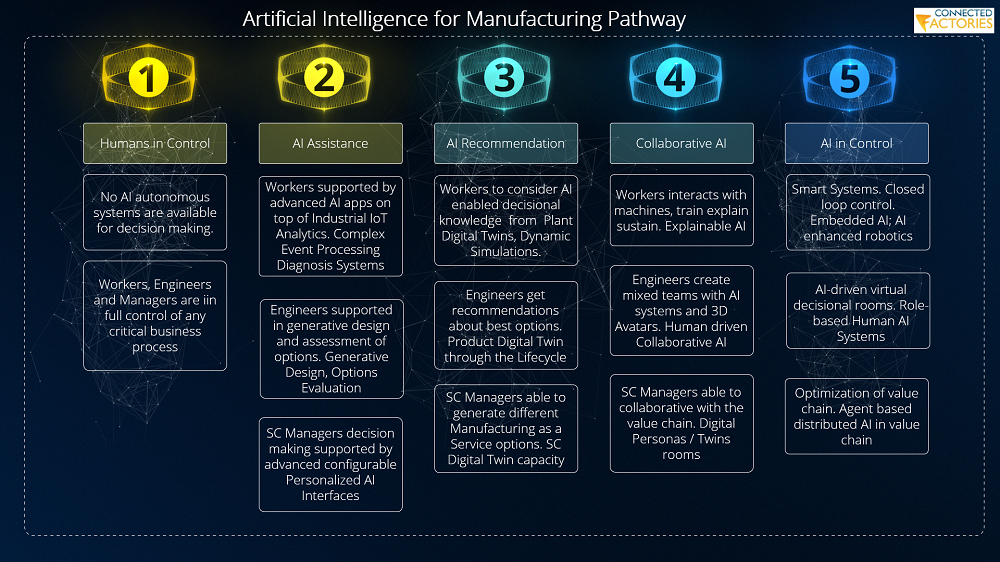AI for Manufacturing pathway
The AI for Manufacturing pathway aims at developing a conceptual model and a series of tools, to position
industrial cases in an evolutionary 5-levels framework related to the adoption of AI in Manufacturing industry
critical business processes.
Owing to the exceptional variety of AI technologies and of application cases in manufacturing, we decided
to consider industrial cases using some (combination) of the following main six technological enablers:
i. Machine Vision and Robotics, very related to the Smart Autonomous Factory CF1 pathway
ii. Embedded AI in Products (Smart Products), very related to the Collaborative Product-Service CF1
pathway
iii. Machine Learning and Knowledge Discovery, very related to 5V Big Data repositories typical of the
Hyperconnected Factories CF1 pathway
iv. AI Forecasting and Prediction, applicable to all CF1 pathways and related to the Foresee cluster of
projects
v. AI Diagnosis and Maintenance, applicable to all CF1 pathways and related to the forZDM cluster of
projects
vi. Recommendation and Decision Support Systems, applicable again to all CF1 pathways in the
presence of Human users and related to the ICT-38 AI4Manufacturing cluster of projects
These enablers are not to be meant as horizontal rows of a matrix, but as inspiration examples on how AI can
support manufacturing processes. Regarding the five levels of maturity, we decided to focus on one precise
aspect of the adoption of AI in Manufacturing (focus on Smart Autonomous Factories of the Future): the level
of autonomy in the Human-AI interaction. The reference model is the Level-0 Level-5 Model of Autonomy of
the German Plattform 4.0 initiative, and in particular the so called MAL4 (Level 4), which is considering the
most relevant challenges in the interaction between Humans and AI systems.
The following picture represents the model of the AI for Manufacturing pathway and its five levels:

Level 1: Humans in Control. AI systems (although sometimes present) do not influence the decisional
processes which are firmly in the hands of the Humans.
Level 2: AI Assistance. AI is able to provide additional information to the user (e.g. hidden knowledge
discovery, clustering of cases, anomaly detection), who is then taking his/her decisions in autonomy
Level 3: AI Recommendation. AI is able to suggest some decisional options, which are then assessed
and evaluated by the Humans
Level 4: Collaborative AI. Virtuous mixed teams of Humans and AI systems are set up and decisions
are taken in a collaborative way thanks to train-explain-sustain interactive patterns
Level 5: AI in Control. AI is taking decisions autonomously especially under real time constraints which
do not allow a human intervention
More information: D2.6_Pathways cross-fertilisation with Digital Technologies - Second Iteration (chapter 4)
(See all ConnectedFactories Deliverables here)
